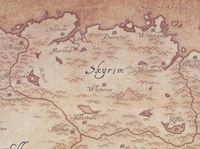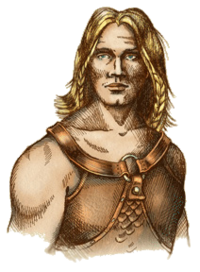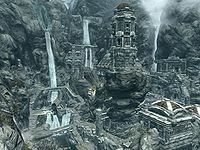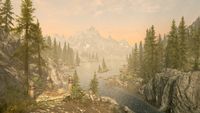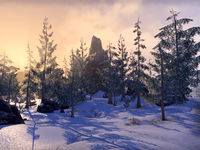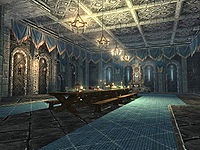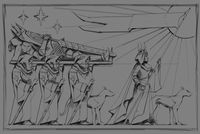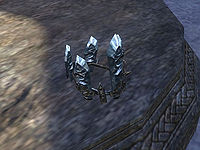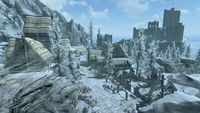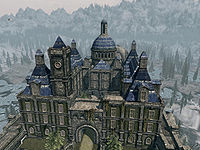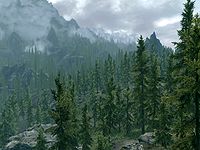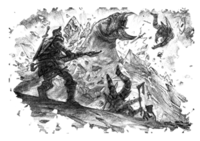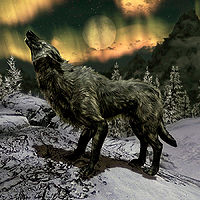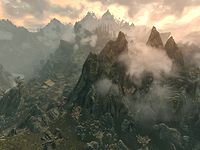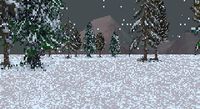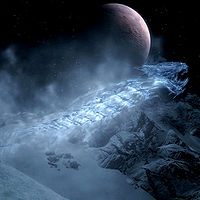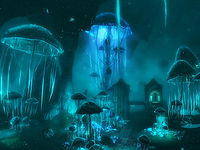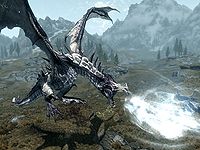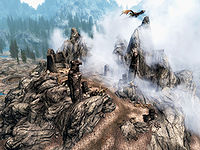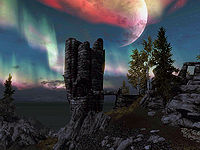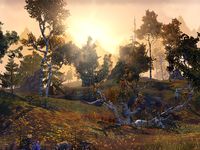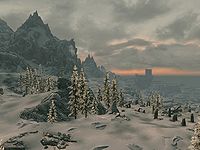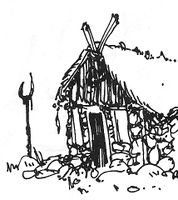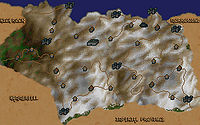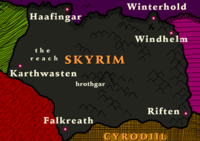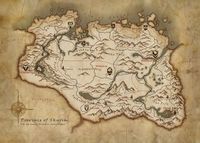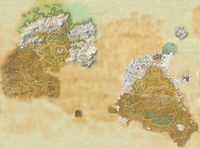Lore:Skyrim
| Skyrim | |
|---|---|
| Type | Province |
| Continent | Tamriel |
| Demonym(s) | Skyrimian[1] |
| Appears in | Arena, Dawnstar, Shadowkey, Skyrim, ESO, Legends |
Skyrim, the northernmost province of Tamriel, is a cold and mountainous region also known as the Old Kingdom, Mereth, or the Fatherland,[2][3] or Keizaal in the dragon tongue.[4] Many past battles have given it a ravaged appearance and many ruins.[2][5] Though currently inhabited primarily by Nords, the Elves who they replaced had resided there since time immemorial.[2][5] The sovereign, the High King of Skyrim, is chosen by the Moot, a convention of jarls.[6] A jarl is a regional ruler chosen through heredity and, rarely, through right of arms.[6][7] The High King typically rules until death, though acts of dishonor, particularly the appearance of cowardice, can lead to the recall and reconsideration of the Moot.[6][8] Since the Pact of Chieftains was signed in 1E 420, the Moot does not give serious consideration to anyone but the High King's direct heir unless one is not available.[2]
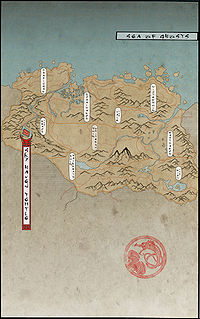
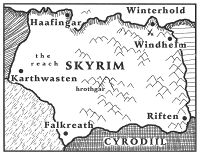
Geography[edit]
Morrowind lies to the east over the Velothi Mountains, Cyrodiil is south beyond the Jerall Mountains, Hammerfell (and the latest incarnation of Orsinium) is to the south and west, High Rock is past the Druadach Mountains to the west, and the Sea of Ghosts runs along the province's long northern coastline. Skyrim holds four of the five highest mountains in Tamriel[2] (the Red Mountain being the only one outside Skyrim). Much of the northern half of Skyrim is cold and covered in snow. However, the southern regions of the province are relatively mild.[7]
Holds[edit]
The Nords long ago divided the province into nine geopolitical regions known as "holds". Each hold is a large area of land roughly equivalent to a county in Cyrodiil, each individually governed by a jarl who maintains court in the hold's capital city. The nine traditional holds of Skyrim are: Haafingar, Hjaalmarch, the Pale, Winterhold, Eastmarch, the Rift, Whiterun, Falkreath, and the Reach.[9] During the Interregnum, when the Reach became an independent Reachman kingdom and lost its status as a Nordic hold, a tenth hold named Karthald was created from the Reach's northern fringe.[10]
Winterhold, Eastmarch, the Rift, and the Pale, lying to the north and east of the province, are collectively known as the "Old Holds", and remain isolated from the rest of Tamriel, both geographically and politically. In contrast, the western hold of the Reach has historically been more cosmopolitan and members of all the races of the continent have made their homes there.[2]
Eastmarch[edit]
Eastmarch is the eastern hold of Skyrim, and one of the four known collectively as the Old Holds. As its name suggests, it lies against the province's eastern border, close to the Dunmeth Pass, the only passage to and from Morrowind in the area due to the high and rugged Velothi Mountains.
Windhelm is the only sizable city in the otherwise rural province due to the expansive hot springs which dominate the hold. According to legend, these hot springs were created when the hero Wuunding fought a mighty Daedra and defeated it with a flaming hammer. The hammer's blows melted the Daedra, leaving behind the numerous hot springs.
Darkwater River winds north from Lake Geir into this treacherous hot spot, where it meets the White River which then drains into the Sea of Ghosts as it passes Windhelm. River Yorgrim also joins with the White River before it ends at the Sea of Ghosts. It drains Lake Yorgrim, which lies west in the hold known as the Pale.
The Pale[edit]
The Pale (also called the Pale Hold or The Tale) is a large region in north-central Skyrim and one of the Old Holds, the original four territories in the province, where ancient traditions continue to thrive. The region acquired its name from both the pale white tundra and the pigmentation of the local Nords. Because of its distinct shape, some people colloquially call it "the old boot". The hold's population is centralized in its capital city of Dawnstar, a seaside town on the Frozen Coast and one of the busiest ports in the province.
Winterhold[edit]
Winterhold is a historical region located on the northeast coast of Skyrim, known for its inhospitable terrain and snow-blown landscape. Centered around the city of the same name, it is one of the Old Holds of Skyrim, which are generally isolated by geography and choice. The Nords of Winterhold are simple fisherfolk and mostly work on the Sea of Ghosts since there is little pasture for grazing and the cold winds prove brutal for livestock. One of the region's most noteworthy landmarks is the College of Winterhold, the province's premier school of magic and center of both academia and arcana.
Hjaalmarch[edit]
Hjaalmarch or Hjaalmarch Hold is a lowland coastal hold in Skyrim. Roughly half the hold consists of the Drajkmyr marsh, south of which is the capital and only major settlement Morthal (although Stonehills and some farmsteads lie on the tundra of Hailstone Valley). The region is veined with waterways that empty into the Sea of Ghosts, and the Skyborn Range further isolates the area from the eastern and southern border.
Hjaalmarch is home to the Karth delta, also called the Mouths of the Karth, where the mighty Karth River and the smaller River Hjaal (from whence the hold's name is derived) empty into the Sea of Ghosts through a variety of intricate channels. The Deathbell flower is known to be abundant throughout the swamps. Many ruins dot the hold, including the legendary Labyrinthian. Combined with the fog that surrounds the marshes and the creatures that stalk the land (Wispmothers purportedly originated here), Hjaalmarch is considered one of the more mysterious holds in Skyrim.
Hjaalmarch has the lowest taxes of the nine holds, but it is also the poorest hold.
Haafingar[edit]
Haafingar (also called Haafingar Hold and the Kingdom of Solitude) is a relatively small, mountainous, coastal hold in northwestern Skyrim. Its capital is the famed city of Solitude, and the two are sometimes treated as one and the same. Solitude is perched atop a large rock outcropping known as the Great Arch, towering high above the Solitude Inlet, which is found at the end of the Karth River and the massive Karth delta. However, Haafingar is far more than just Solitude. The Karth River allows for a great deal of commerce in Solitude and the town of Dragon Bridge in the Karth River Forest (mostly in timber and fish), and the long Giant's Coastline with the Sea of Ghosts is littered with frozen shipwrecks and treasures. Mount Kilkreath and its associated mountains take a large portion of the hold and it is filled with caves and ruins where bandits and creatures make their homes.
The hold shares borders with two other holds, the Reach to the south and Hjaalmarch to the southeast, and the province of High Rock borders it to the west, the Forgotten Vale found between the hold and Wrothgar. The mountains of Haafingar are only the tapered end of the Druadach Mountains, an enormous range of jagged mountain peaks to the south which rise up among the clouds of the Reach.
The Reach[edit]
The Reach (also known as Karth) is a geographic region surrounded by High Rock, Skyrim and Hammerfell. Its territory once extended into High Rock, but that portion was split off to create the Western Reach during the late First Era and has remained separate ever since. The region was historically inhabited by the native, Daedra-worshipping Reachmen. Control of the Reach has changed hands between the Reachmen, Nords, and even the Cyrodilics numerous times over the centuries in various conflicts, and the Reachmen became well-known for resisting foreign rule by using ancient magic and an intimate knowledge of the landscape to their advantage in guerrilla warfare and espionage tactics.
In the Fourth Era, the Reach is the southwestern hold of Skyrim. Near the southwestern corner, the capital Markarth, formerly a Dwemer stronghold, emerges from the living rock of the Druadach Mountains, which transition into the Jerall Mountains near the hold's southeast corner. The Karth River begins in the southern region and drains the mountains, running like a deep gouge through the middle of the hold called the Karth River Canyon. Settlements such as Karthwasten and Old Hroldan can be found along the Karth, with the Sundered Hills bordering Whiterun's Tundra Plateau to the east. The peaks of the Druadach range lie to the west of it, and high bluffs typically rise on the east leading to grassland and tundra. The Reachmen constitute the demographic majority of the Reach and its various settlements, and an Orc stronghold can be found in the steppes of the mountains in the south of the hold.
Karthald[edit]
Karthald is a historical hold in Skyrim that existed during the Interregnum. It was established as a defensive border against the Reach after being carved from its northern territory of the upper Karth Valley named Reachwater Pass, along with parts of the Karth River Forest. The Reach was at the time an independent Reachman kingdom ruled by the Ard Caddach. Karthald was established in 2E 577 by the kingdom of Western Skyrim, although Nordic clans had inhabited the land for generations alongside the Reachfolk. The fortified village of Karthwatch was established in as the new hold's capital. Karthald's borders also encompassed the Orc stronghold of Mor Khazgur, though the Orcs were keen to insist that Mor Khazgur was a sovereign outpost of Wrothgar. While the roads of Karthald were safe enough for travelers, Karthwatch was a spartan settlement with little hospitality to offer.
Karthald ceased to exist as a separate hold after the destruction of Karthwatch at the hands of the Icereach Coven circa 2E 582. In retaliation for the prior massacre of a local Reachfolk clan by the Nords and the alleged kidnapping of the crucial clan heir, Bjora, they launched an assault. The Reachmen created a Harrowstorm above the town in order to drain the life energy of its inhabitants, using their souls to fill ancient reliquaries containing the mortal remains of members of the Gray Host. Many of the residents of Karthwatch were transformed into vampiric monstrosities known as Harrowfiends, including Jarl Olfwenn herself. Others were taken hostage by the witches, although a rescue was mounted by the town's survivors. The sole survivor of the jarl's court was the court wizard, Magister Fridelja, who went on to represent the hold politically in the turmoil that followed. She and the other survivors sought refuge in Solitude. However, the rest of the hold was similarly laid to waste, its people left dead or scattered. With the Nords driven out and the hold's capital destroyed, Karthald was no more, allowing the territory to be reclaimed by the Reach.
In 2E 852, the Reach was conquered by Tiber Septim and annexed by Skyrim as a Nord hold. By the Fourth Era, no traces of Karthald's time as a hold remained, and a ruined fortress called Broken Tower Redoubt sat on the approximate site of Karthwatch.
Whiterun Hold[edit]
Whiterun Hold is a hold in Skyrim, located roughly in the middle of the province. Roads are numerous and well maintained, and visibility across the tundra plains is excellent. The hold is relatively flat, surrounded the by mountains of the Reach to the west of the Tundra Plateau, the Skyborn Range of Hjaalmarch and the Yorgrim Forest of the Pale to the north, and the Brittleshin Hills of Falkreath to the south. However, Whiterun's southeastern corner is dominated by the gigantic and soaring Throat of the World—the highest mountain in all of Tamriel. The peak of Lone Mountain is found in the center of the hold.
Whiterun is certainly one of the most well-tracked holds, with main roads and excellent access west to the Reach, with a border road north through the town of Rorikstead and up toward Dragon Bridge. The plains have a number of odd barrows and giant camps to investigate, and the center is dominated by Fort Greymoor and the surrounding Greymoor Foothills. The road here allows travel to the north, up through the Skyborn mountains to reach the dreaded Labyrinthian in Hjaalmarch. Further east is Whiterun and the roaring White River and town of Riverwood on the southern border with Falkreath. Another road stretches north from here, into the wilds of the Pale. There's yet another road that skirts the northern foothills of the Throat of the World, following White River Valley into Eastmarch. Although the first of the 7,000 steps that pilgrims climb to reach the summit of Throat of the World begins in Ivarstead (in the Rift), the actual mountain lies within Whiterun's domain.
It borders six of the other eight holds in Skyrim, the exceptions being Winterhold and Haafingar. Giants are often seen traversing the landscape while herding mammoths to grazing areas or back to their camps. Surrounding the eponymous capital, Whiterun, are fertile plains dotted with farms that supply the food for much of Skyrim. The other notable settlements in the hold are Rorikstead and Riverwood.
Falkreath Hold[edit]
Falkreath Hold (or simply called Falkreath) is one of the main holds of Skyrim, known for its lush pine forest. Lake Ilinalta is the province's largest body of freshwater and it takes a significant portion of the hold. Falkreath has an ancient association with battle and death as its capital city is known as the "heroes' graveyard" and contains one of the largest sites in the province. Its people are generally prosperous farmers and loggers, thanks to the Ilinalta. Throughout history, Falkreath has shifted between the Kingdom of Skyrim and the Colovian Estates, the autonomous government of western Cyrodiil.
The Rift[edit]
The Rift (sometimes called Rift Hold) is a large region in the southeastern portion of Skyrim and one of the Old Holds, the eastern Skyrim territories isolated by geography and choice as the local Nords have stuck close to ancient traditions. The Rift is distinct for its temperate climate and autumn forest, thanks to the mountains surrounding it blocking extreme temperatures from the east and north. The capital of the hold is Riften, formerly the epicenter of a vast trading network between Skyrim and Morrowind.
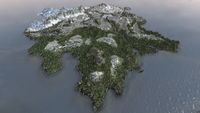
Solstheim[edit]
Although the history of the island of Solstheim is somewhat complicated, there was a time when it was considered a part of Skyrim.[11] The Skaal, an offshoot tribe of Nords, inhabit the northeastern corner of the island.[12][13] In 3E 433, the Nords of Skyrim launched a successful campaign to claim the whole of Solstheim.[14] In 4E 16, the High King of Skyrim formally gave the island to Morrowind as a refuge for the Dunmer after the events of Red Year.[11] The northern half of the island is snowy and mountainous. The southern half was originally covered in coniferous forests, but after the Red Year it was transformed into an ashland similar to those seen in Morrowind.[12][13]
Bleakrock Isle[edit]
Bleakrock Isle, also considered a part of Skyrim, is a small, snowy island in the Sea of Ghosts between Windhelm, Blacklight and Solstheim. A small populace of the Nords inhabited the Bleakrock Village until they were driven from the island by the Daggerfall Covenant in 2E 582. It is unknown if the island was resettled afterwards.[15]
Icereach[edit]
Icereach is a small island in the Sea of Ghosts. Once used by the Nords as an outpost to protect whalers from Orcish corsairs, the island eventually became the home of a coven of Reachfolk witches who adopted the island's name. While the Nords believe that the Icereach Coven seized the island by force, the coven maintain they acquired it through a cursed bargain with its original Nordic inhabitants. Around 2E 582, the Icereach Coven was defeated by an expeditionary force sent by High King Jorunn to investigate strange storms around the island that had been caused by the witches' rituals.[15]
History[edit]
Skyrim's history is mostly that of the Nords. The Nords believe the sky, Kyne, breathed life into them at the summit of the Throat of the World, which is now considered the tallest mountain in Tamriel (the Red Mountain was acknowledged as the tallest before its eruption during the Red Year).[16][2][17] While historians tend to portray Ysgramor as the first Nordic settler of Skyrim, ushering in concurrent waves of immigration from Atmora, this is not the case. While their exact origins are unknown, the most widely accepted theory is that the early Nedic peoples (a now extinct culture) settled in Skyrim after arriving from Atmora well before the arrival of Ysgramor, and from there spread to the rest of Tamriel.[18]
In ancient times, Skyrim was ruled by the malevolent Dragon Cult. This early society revolved around the worship of dragons through intermediaries known as dragon priests, who ruled as gods above men. Sometime in the late Merethic Era, the mythical Dragon War saw the overthrow of the Dragon Cult when Alduin, Akatosh's firstborn, was defeated atop the Throat of the World. The veneration of animals as gods was eventually replaced by the Eight Divines.[19]
The many mountain ranges in and around the province resulted from unknown cataclysms in the Dawn Era.[5] The only known relic from this time is the Skyforge, an ancient, powerful, and still-active forge built into the living rock in modern-day Whiterun. Who built it remains a mystery, but the Elves feared it, and this led the invading Atmorans to claim it for themselves.[20]
The Aldmer and Snow Elves occupied Skyrim until the late Merethic Era, when the final wave of Nordic immigration from Atmora, led by Ysgramor, finally established Nordic supremacy in modern-day Skyrim.[2][18] Settlers from Atmora crossed the Sea of Ghosts and made landfall here many times, often clashing with those who had already established themselves.[5][18] These early settlers called the land "Mereth", after the Elves that roamed the untamed wilderness. While the Nedic peoples were generally peaceful, the arrival of Ysgramor and the proto-Nords sparked a long, antagonistic chain of conquests that ultimately expelled the Elves from Skyrim.[19][2] The instigating spark of conflict was the infamous Night of Tears, where the Elves attacked the human settlement of Saarthal. According to Imperial scholars, the Elves realized that this newer race could outpace their relatively stagnant own. Others posit that the human inhabitants had discovered a powerful artifact, the Eye of Magnus, that the Elves desired.[7] Nonetheless, Ysgramor escaped the carnage, returning to Skyrim with his now legendary band of Five Hundred Companions, slaughtering the Elves and establishing man as the foremost race in Skyrim.[2] Ysgramor's clan expanded their territory, and it continued to expand and contract by winning and losing territories in Morrowind and High Rock during the First Era.[2][5][21] Elven rule of Skyrim is thought to have ended under the reign of King Harald (1E 143 - 1E 221), though pockets of Snow Elves hid away in the wilderness.[2]
In the years after 1E 420, however, the Dwemer of Clan Kragen migrated into Skyrim from Resdayn, following in the footsteps of Clan Rourken's exodus. Clan Kragen founded the city of Arkngthamz, which flourished despite constant attacks from the Nords. The success of Arkngthamz encouraged other Dwemer clans to settle in Skyrim, and these joined with Clan Kragen to form a loose alliance of four city-states that were considered unassailable. Clan Kragen's presence eventually extended further west into the Dragon's Teeth Mountains, where they carved out an even larger bastion called Arkngthamz-Phng.[22] The prosperity of Skyrim's Dwemer city-states was relatively short-lived, as the discovery of rich deposits of Aetherium and the creation of the Aetherium Forge immediately shattered the alliance and launched decades of internal conflict. With the Dwemer distracted and weakened, the Nords under High King Gellir finally conquered the squabbling city-states in only three years, though the Dwemer would return a century later and reclaim their former holdings.[23] When the entire Dwemer race disappeared around 1E 700, they left behind the Falmer, Snow Elves who they had allowed to take refuge with them and then twisted into rebellious slave monsters.[24] They remained under the ground, occasionally making forays to the surface and creating legends among the Nords of their presence and malevolent intent.[2][24]
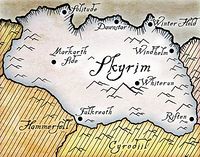
After the assassination of High King Logrolf in 2E 431, a dispute over the succession resulted in Skyrim's division into two independent kingdoms. It began when Jarl Svartr of Solitude challenged the legitimacy of Logrolf's heir, Freydis, and a Moot was convened. Although Freydis was accepted by the Crown of Verity, a magical artifact crafted to test the worthiness of potential rulers of Skyrim, and named High Queen in Windhelm, a partial Moot held in Solitude declared Svartr to be High King.[25] From then on, Skyrim was divided into two kingdoms: Eastern Skyrim and Western Skyrim. In the east, Freydis and her successors ruled over The Rift, Eastmarch, The Pale, and Winterhold,[25][26][27] while in the west, Svartr and his successors ruled over Falkreath,[28][29] Whiterun Hold,[29][28] Hjaalmarch,[30] Haafingar,[31] and later the newly-established hold of Karthald.[10][25][27] This schism persisted at least until the time of the Three Banners War in 2E 582;[32] Eastern Skyrim fought in the war as a member of the Ebonheart Pact, while Western Skyrim remained neutral.[33] At that time, The Reach did not belong to either kingdom and the Reachmen had banded together under the Despot of Markarth, who allied himself with Mannimarco.[19][27] The two kingdoms of Skyrim, as well as The Reach, were eventually reunified into a single realm following the Tiber War.[34][35]
During the Imperial Simulacrum, the Kingdom of Skyrim waged the War of the Bend'r-mahk against High Rock and Hammerfell, temporarily annexing the territories of Jehanna from High Rock, and Elinhir and the northern half of Dragonstar from Hammerfell.[5]
Orc strongholds dot the wilderness; many Orcs were escorted into Skyrim by the Imperial Legion following the sacking of Orsinium in the early Fourth Era.[36] Besides the Orcs, the Elven population has also increased due to the Red Year of 4E 5, when natural disasters in Morrowind sent many Dunmer fleeing into eastern Skyrim.[37][38] Following the Great War, Thalmor officials hunted for and persecuted Talos worshippers, thus bringing some small measure of Elven rule back to Skyrim.[7][39] While these smaller creatures vied for dominance over the millennia, the Giants have been largely ignored (and often protected by law).[7]
Known Rulers[edit]
The political structure of the Elves who first inhabited Skyrim is unknown. When the Atmorans first migrated to Skyrim, before the Dragon War of the Merethic Era, the Dragon Priests of the Dragon Cult held roles on par with kings, but the Atmorans recognized relatively secular chieftains as their leaders.[2][40] Ysgramor is the first known human ruler of Skyrim.[2] His progeny would continue to rule after his death as the Ysgramor Dynasty; King Harald, the 13th of his line, is considered the first "historical" ruler.[18][41] Since Harald's time or even before, the High King traditionally wore the Jagged Crown, though it was lost with King Borgas in 1E 369 until its rediscovery in 4E 201.[7] A new symbol of rulership, the Crown of Verity, later called the Crown of Freydis, was crafted to determine the worthiness of potential rulers following the death of Olaf One-Eye, but has not been seen beyond the Second Era.[25] Known High Kings/Queens and their reigns are listed below:
Capitals of Skyrim[edit]
In practice, the city where the High King resided also served as the capital of Skyrim. This has changed over the course of centuries, and at times of division there was more than one capital city. When the Dragon Cult dominated Skyrim until the late Merethic Era, the capital was at one point Bromjunaar, located at what would later be called Labyrinthian. When Harald assumed the mantle of High King in 1E 143, he relinquished his holdings in Atmora and established Skyrim as an independent kingdom with Windhelm as its capital.[18][2] During the time of Vrage the Gifted (r. 1E 222 – ?), Windhelm became the capital of not just Skyrim, but the First Empire of the Nords that also encompassed High Rock, Morrowind, and parts of Cyrodiil.[2] High King Borgas (died 1E 369) ruled from Winterhold, however.[47] High King Olaf One-Eye (r. 1E 420 – 1E 452) resided in Whiterun.[48] In the late First Era, Solitude served as the seat of High Queens such as "Head-Rolling" Roleke and High Kings like Alldimar the Ghostmaker.[51] During the schism of the Second Era (since 2E 431), Svartr and his descendants ruled the Kingdom of Western Skyrim from Solitude, while Freydis and her descendants reigned the Kingdom of Eastern Skyrim from Windhelm.[25] Winterhold was counted among other provincial capitals circa 3E 427.[62] Solitude had been the capital of Skyrim for several years by 4E 201.[63]
Architecture[edit]
Nord architects are masters of creating structures that last for generations, with designs that can be found from Bruma to Solstheim dating over 3,000 years old.[2][19] Many ancient Nordic ruins built into the mountains dating back to the Merethic and First eras remain standing throughout Skyrim.[7] They are towering, foreboding structures of black granite. Some were settlements and temples from when the Nords lived under the rule of the Dragon Cult and after; others are burial tombs for the honored dead. Most modern buildings in Skyrim are built partly underground to conserve heat, and are made with stones, with wood used only for support, and roofs of straw. The Nords are known as masters of lumber construction, and these houses are essential to keep in heat in the freezing climate.[2] Some Nord wells are known to have spikes attached to the bottom of buckets to crack through ice.[19]
After the reign of Ysgramor, Nord stonesmiths created a method of erecting igneous rock. Initially, these blocks were hewed from porphyry deposits, although by the Second Era, they were somewhat supplanted by hard-wearing granite and volcanic stone gathered from the eastern side of the province. Each block was slotted together without requiring seams or mortar, allowing huge walls, structures, and towers to be constructed with both ease and haste, even with irregularly-shaped stone. Many of these structures proved difficult for invaders to dismantle, such as the Old Fort, a royal bastion on Skyrim's northern frontier, which still stood in the mid-Second Era after being built in the time of the First Empire.[19][2]
Flora[edit]
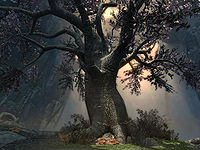
Skyrim's frigid environment still supports a great wealth of flora, notably its many pine forests.[17][64] Many of its plants and fungi are useful for alchemy, including bleeding crown mushrooms, the Deathbell flower, Jazbay grapes, and Nightshade. Tundra cotton is not only used for making potions, but for making many of the fabrics for clothing and other purposes in Skyrim.[64]
Crimson Nirnroot is a special variant of nirnroot that can be found exclusively in the caverns of Blackreach beneath the province.[65]
Fauna[edit]
The beasts of Skyrim are as diverse as they are dangerous. Horkers line the northern coast, posing a greater danger to hunters and fisherman, and ice wolves prowl in pairs all over the province.[7][66] Slaughterfish and other types of fish glide through the rivers and lakes.[7] Other common beasts roam the wilderness, and rumors abound of less common ones like werewolves and Wispmothers.[67] Many of them, such as Hagravens and luna moths, yield body parts used in alchemy.[64] Ice wraiths and other creatures are hunted in the mountains by young traditional Nords as rites of passage.[2][68] Undead Draugr still guard the ruins of the province.[69] Of course, the most legendary "creatures" are the majestic and intelligent Dragons, who have left their mark on Skyrim in more ways than one. Ancient structures dedicated to the Dragon Cult and "word walls" in the language of the dragons still dot the landscape.[7][70]
Notable Places[edit]
- Bleakrock Isle
- A small island northeast of Skyrim and south of Solstheim.
- College of Winterhold
- A famous school for Magic in the city of Winterhold.
- Dawnstar
- A busy port on the northern coast and capital of the Pale.
- Dunmeth Pass
- The main pass and one of the few traversable roads leading through the Velothi Mountains between northwestern Morrowind and eastern Skyrim.
- Falkreath
- The capital of the eponymous hold is in southwestern Skyrim, close to the border with both Cyrodiil and Hammerfell.
- Lake Geir
- A lake in the western Rift.
- Hsaarik Head
- At the extreme northern tip of Skyrim's Broken Cape, it is the place where tradition holds that Ysgramor's Five Hundred Companions made landfall.
- Lake Ilinalta
- A lake in west-central Falkreath Hold, in the middle of Skyrim's Pine Forest.
- Karth River
- A western river running the length of Skyrim before emptying into the Sea of Ghosts near Solitude.
- Labyrinthian
- An ancient Nordic ruin. Named for the labyrinth built sometime in the First Era by Arch-Mage Shalidor, although the ruins themselves are much older, having been the city of Bromjunaar, the capital of the Dragon Cult.
- Markarth
- The capital of the Reach is in the southwest corner of the province.
- Morthal
- The fairly small, humble town of little economic or strategic importance is noteworthy as the capital of Hjaalmarch.
- Pale Pass
- A secluded pass through the Jerall Mountains on the Cyrodiil-Skyrim border.
- Riften
- The capital of the Rift, long a center for crime, lies close to both Cyrodiil and Morrowind.
- Saarthal
- An ancient Nordic city that was sacked in the Night of Tears, Saarthal is where the Eye of Magnus was found in the Fourth Era.
- Sky Haven Temple
- Fortress stronghold in the Druadach Mountains built by Reman Cyrodiil's Akaviri Dragonguard.
- Snowhawk
- A city located in Hjaalmarch, abandoned sometime during the Fourth Era.
- Solitude
- A major port city and capital of Haafingar.
- Throat of the World
- The highest peak in the province of Skyrim. Though once considered second to Red Mountain, it is now known as the highest mountain in all of Tamriel.
- Treva River
- A river at the center of the Rift. It flows from Lake Honrich to Lake Geir.
- White River
- The longest river in Skyrim, stretching from the south of the province to the northeast corner. Its source is Lake Ilinalta, north of Falkreath. It flows northeast to join the Sea of Ghosts past Windhelm.
- Whiterun
- A city in central Skyrim, and the capital of Whiterun Hold. Built at the spring of the White River.
- Windhelm
- The capital of Eastmarch lies close to the border with Morrowind. It's the famed location of the Palace of the Kings.
- Winterhold
- The capital of the eponymous hold was once quite prosperous, but was devastated in the Great Collapse in 4E 122.
Gallery[edit]
Maps[edit]
Notes[edit]
- ^ During the War of Succession there was no High King for approximately 51 years.
- ^ Rislav The Righteous states that Kjoric the White was killed eight months before certain events in 1E 478, placing his death either in that year or in 1E 477.
- ^ Hoag Merkiller was said to have died at the Battle of Glenumbria Moors, after which Wulfharth ascended to the throne. However, some sources place the date of the battle at 1E 480, and others at 1E 482.
- ^ Gellir could not have reigned any earlier than 1E 533. His chief accomplishment is the conquest of Skyrim's Dwemer city-states, and according to Arkngthamz-Phng, those city-states were not established until the decades after Clan Rourken founded Volenfell in 1E 420. Since the consecutive reigns of four other High Kings span the years between 1E 420 and 1E 533, Gellir could only have ruled sometime after 1E 533. The Aetherium Wars notes that the Dwemer reclaimed their lands "a century" after Gellir's conquests, and since the Dwemer had disappeared by 1E 700, it is likely that Gellir's reign occurred before the end of the 6th Century of the First Era. The Elder Scrolls V: Skyrim: Prima Official Game Guide and Katria's dialogue both state Arkngthamz was abandoned over four thousand years before Skyrim, contradicting this, as 4,000 years before 4E 201 is 1E 451.
- ^ This unidentified descendant of Temylda was crowned High King forty years after Temylda's death while still a child. He was quickly usurped by Alldimar the Ghostmaker according to Scandals of Solitude's Royalty.
- ^ Skyrim split into independent Eastern and Western kingdoms in 2E 431 amid a dispute over the succession. Freydis was proclaimed High Queen in Windhelm, and her successors (who include Mabjaarn Flame-Hair, Nurnhilde, and Jorunn the Skald King) ruled Eastern Skyrim. Svartr was proclaimed High King in Solitude, and his successors ruled Western Skyrim.
- ^ The map of PGE1S displays Winterhold as the capital of Skyrim Province.
- ^ During the Stormcloak Rebellion there was no High King. The kingship was claimed both by the rebel leader Ulfric Stormcloak, Jarl of Windhelm, who killed the previous High King Torygg, and by Torygg's widow Elisif the Fair, Jarl of Solitude, who was supported by the Empire.
See Also[edit]
- For game-specific information, see the Arena, Dawnstar, Shadowkey, Skyrim, Elder Scrolls Online, and Legends articles.
Books[edit]
- The Aetherium Wars by Taron Dreth — A treatise on the collapse of Dwemer city-states in Skyrim
- Amongst the Draugr by Bernadette Bantien, College of Winterhold — Discoveries about the draugr and their link to the dragon cults
- Annals of the Dragonguard by Brother Annulus — Chronicles of the Dragonguard in the late First Era
- Arkngthamz-Phng by Neramo — A history of the Dwemer Clan Kragen's expansion into Skyrim
- Atlas of Dragons by Brother Mathnan — A glossary of Skyrim's dragons
- The Bear of Markarth by Arrianus Arius, Imperial Scholar — An account of Ulfric Stormcloak's short-lived independent reign over the Reach
- Before the Ages of Man by Aicantar of Shimerene — Chronicles the major events of the Dawn and Merethic Eras
- The Betrayed by Engwe Emeloth — A poem surrounding the tragic fall of the Snow Elves
- Biography of the Wolf Queen by Katar Eriphanes — A history of the unambiguously evil Queen Potema, the so-called Wolf Queen of Solitude
- Brief History of the Empire by Stronach k'Thojj III — A description of events in the history of the Empire
- Cats of Skyrim by Aldetuile — A brief treatise on the few felines that can be found in Skyrim
- Children of the Sky — A description of the Nords and the Thu'um
- The City of Stone by Amanda Alleia — A mercenary's guide to Markarth
- Deathbrand — The tale of a legendary pirate and his treasure
- Dragon Language: Myth no More by Hela Thrice-Versed — A lengthy thesis on the ancient language of the dragons
- The Dragon War by Torhal Bjorik — A religious text describing the primordial war between men and dragons
- Dunmer of Skyrim by Athal Sarys — A proclamation of Dunmer supremacy in eastern Skyrim
- Dwemer Inquiries by Thelwe Ghelein, Scholar — A series of scholarly essays on the elusive Dwemer
- Fall from Glory by Nithilis Lidari — Theories on the weakening of the Skyrim Thieves Guild
- The Falmer: A Study by Ursa Uthrax — A study on Falmer, recounting their war with the Dwemer
- Five Songs of King Wulfharth — A summary of five epic songs of the Ash King, plus an apocryphal song of the Tribunal, Dagoth-Ur and Nerevar
- Frontier, Conquest by the University of Gwylim Press, 3E 344 — Details the presence of humans in Tamriel before the original Nordic conquests thought to bring humans to Tamriel
- A Gentleman's Guide to Whiterun by Mikael the Bard — A bard's description of life in the city of Whiterun
- Great Harbingers by Swyk the Long-Sighted — Chronicle of some of the leaders of the Companions
- Herbalist's Guide to Skyrim by Agneta Falia — A description of alchemy ingredients found in Tamriel's northernmost province, Skyrim
- Herbane's Bestiary by Herbane — A guide to some of the creatures you may encounter while exploring Skyrim
- Holdings of Jarl Gjalund by Slafknir the Scribe — An ancient list of settlements within Whiterun Hold
- The Holds of Skyrim — The official guide of the Imperial Legion to Skyrim and its holds
- Imperial Report on Saarthal by Heseph Chirirnis — A report from a Mages Guild Scholar assigned to Imperial Archaeologist Sentius Floronius
- The Legendary Sancre Tor by Matera Chapel — An attempt to chronicle the rise and fall of Sancre Tor
- Lost Legends by Talsgar the Elder, Archivist of Winterhold — A collection of less well-known folk tales from Skyrim's past
- A Minor Maze — A brief history of Labyrinthian
- Night of Tears by Dranor Seleth — An inquiry into the cause of the Night of Tears
- Nords Arise! by Anonymous — Stormcloak's recruitment essay calling for rebellion against the Empire
- Nords of Skyrim by Hrothmund Wolf-Heart — An essay professing the finer qualities of Nords
- Notes on Yngol Barrow — A scholar's transcription of ancient Nord writings in a Skyrim barrow
- Of Crossed Daggers by Dwennon Wyndell — The story of Riften's fall from grace
- On the Great Collapse by Arch-Mage Deneth — A letter from the Arch-Mage of the College of Winterhold to the Jarl following the Great Collapse
- Orcs of Skyrim by Thora Far-Wanderer — A history of the Orcish settlers and strongholds of Skyrim
- Pocket Guide to the Empire, 1st Edition: Skyrim by Imperial Geographical Society
- Pocket Guide to the Empire, 3rd Edition: The Throat of the World: Skyrim by the Imperial Geographical Society
- Scourge of the Gray Quarter by Frilgeth Horse-Breaker — A complaint on the presence and behavior of the growing Dunmer population of Skyrim
- Shadowmarks by Delvin Mallory — A list of symbols members of the Thieves Guild leave behind for each other
- Skyrim's Rule by Abdul-Mujib Ababneh — A Redguard explains Skyrim's political system
- Songs of Skyrim: Revised by Giraud Gemaine, Historian of the Bards College, Solitude — A compilation of popular songs in Skyrim
- Songs of the Return — Parts of the traditional legend of Ysgramor and his Five Hundred Companions
- Varieties of Faith... by Brother Mikhael Karkuxor of the Imperial College — An expansive list of the pantheons and associated divine spirits of Tamriel's dominant cultures
- Walking the World, Vol XI by Spatior Munius — A comprehensive description of the city of Solitude
- Watcher of Stones by Gelyph Sig, Thane of Bjorin — Musings on the Guardian Stones of Skyrim
- The Windhelm Letters by Reylia — A series of letters written in the Second Era from a woman in Windhelm to her husband in Solitude
- The Wolf Queen by Waughin Jarth — The life story of Queen Potema
References[edit]
- ^ The Elder Scrolls: The Official Cookbook Vol. 2 — Erin Kwong
Victoria Rosenthal - ^ a b c d e f g h i j k l m n o p q r s t u v w x y Pocket Guide to the Empire, 1st Edition: Skyrim — Imperial Geographical Society, 2E 864
- ^ Provinces of Tamriel
- ^ Odahviing's dialogue
- ^ a b c d e f Pocket Guide to the Empire, 3rd Edition: The Throat of the World: Skyrim — Imperial Geographical Society, 3E 432
- ^ a b c Skyrim's Rule — Abdul-Mujib Ababneh
- ^ a b c d e f g h i j k Events of Skyrim
- ^ a b c Sybille Stentor's dialogue in Skyrim
- ^ The Holds of Skyrim
- ^ a b Guide to Western Skyrim: Karthald — Imperial Surveyor Buntara Gravius
- ^ a b Loading screen in Skyrim: Dragonborn
- ^ a b Events of Morrowind: Bloodmoon
- ^ a b Events of Skyrim: Dragonborn
- ^ Rumors in Oblivion
- ^ a b c d e Events of ESO
- ^ Children of the Sky
- ^ a b Loading screen in Skyrim
- ^ a b c d e f g Frontier, Conquest — University of Gwylim Press, 3E 344
- ^ a b c d e f The Improved Emperor's Guide to Tamriel: Skyrim — Flaccus Terentius, 2E 581
- ^ Songs of the Return, Vol 7
- ^ The Legendary Sancre Tor — Matera Chapel
- ^ Arkngthamz-Phng — Neramo
- ^ a b The Aetherium Wars — Taron Dreth
- ^ a b The Falmer: A Study — Ursa Uthrax
- ^ a b c d e f g h i j k The Crown of Freydis — Taleon Mythmaker
- ^ East Skyrim Scout Outfit's item description in ESO
- ^ a b c Loremaster's Episode of ESO-RP ZOS Interview
- ^ a b Meet the Character - Eerika Skjoralmor
- ^ a b West Skyrim Scout Outfit
- ^ Guide to Western Skyrim: Hjaalmarch — Imperial Surveyor Buntara Gravius
- ^ Guide to Western Skyrim: Haafingar — Imperial Surveyor Buntara Gravius
- ^ a b c d Second Invasion: Reports
- ^ The Second Akaviri Invasion — Yngmaer Raven-Quill, Historian Royal of the Bards' College, Solitude
- ^ The Arcturian Heresy — The Underking, Ysmir Kingmaker
- ^ Kibell's dialogue in Skyrim
- ^ The Infernal City — Greg Keyes
- ^ The Red Year — Melis Ravel
- ^ Dunmer of Skyrim — Athal Sarys
- ^ Nords Arise! — Anonymous
- ^ The Dragon War — Torhal Bjorik
- ^ The Annotated Anuad
- ^ a b Falkfyr's Complete Report — Scout Falkfyr
- ^ Fanciful Map of the Rift item description
- ^ a b c d e f Plaque in Windhelm
- ^ a b c The Daggerfall Chronicles — Ronald Wartow
- ^ King Edward, Part X — Anonymous
- ^ a b c A History of Daggerfall — Odiva Gallwood
- ^ a b Olaf and the Dragon — Adonato Leotelli
- ^ a b Walking the World, Vol XI — Spatior Munius
- ^ On Oblivion — Morian Zenas
- ^ a b c d e f g h i j k Scandals of Solitude's Royalty — Erisa Sylbenitte of the Coterie of Organized Scholars
- ^ Crafting Motif 4: Nord Style — Doctor Alfidia Lupus
- ^ Oengul War-Anvil's dialogue in Skyrim
- ^ a b c d e f The Brothers' War
- ^ Jorunn the Skald-King — Helgreir Lute-Voice, Bard of Windhelm
- ^ Jakolar's Journal — Jakolar
- ^ Appearance of Jarl Svana in ESO
- ^ a b The Wolf Queen, v8 — Waughin Jarth
- ^ Biography of the Wolf Queen — Katar Eriphanes
- ^ Solstheim loading screens in Skyrim: Dragonborn
- ^ Events of Skyrim The Adventure Game
- ^ Map of Tamriel – Morrowind Codex
- ^ Thaer's dialogue in Skyrim
- ^ a b c Herbalist's Guide to Skyrim — Agneta Falia
- ^ Sinderion's Field Journal — Sinderion
- ^ Horker Attacks — Heidmir Starkad
- ^ Lost Legends — Talsgar the Elder, Archivist of Winterhold
- ^ Herbane's Bestiary — Herbane
- ^ Amongst the Draugr — Bernadette Bantien, College of Winterhold
- ^ Dragon Language: Myth no More — Hela Thrice-Versed
Note: The following references are considered to be unofficial sources. They are included to round off this article and may not be authoritative or conclusive.
|
||||||||||||||||||||
